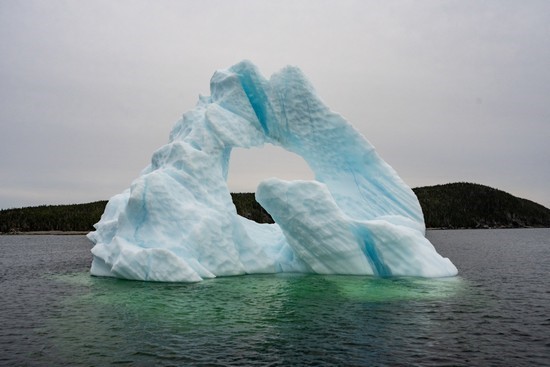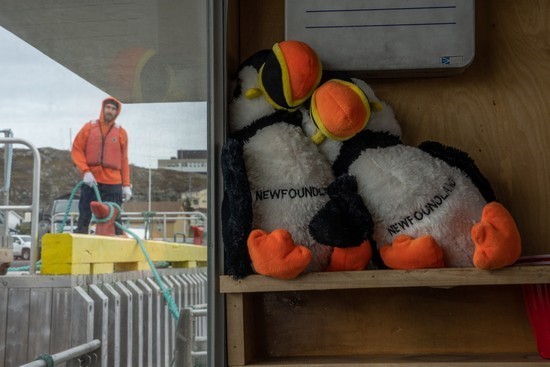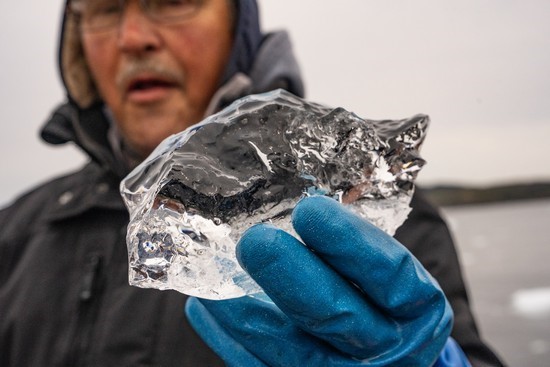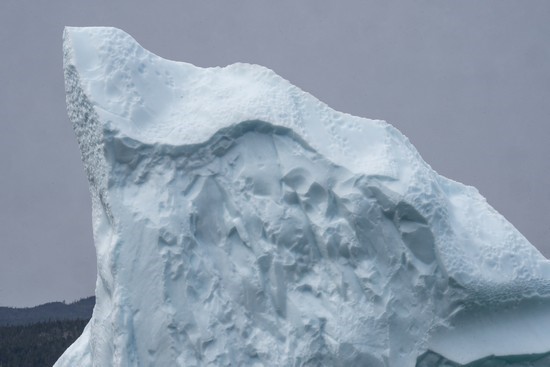“I never trust the mind of an iceberg,” Cecil Stockley said.
He estimates its length, multiplies by five and keeps his boat at least that
distance away.
اضافة اعلان
Dave Boyd said his safety rules depend on which type of
iceberg he is dealing with. “A tabular is generally pretty mellow,” Boyd
explained as we floated off the coast of Newfoundland, referring to icebergs
with steep sides and large, flat tops. “But a pinnacle” — a tall iceberg with
one or more spires — “can be a real beast.”
Barry Rogers does not just look at an iceberg; he listens to
it, as well. When the normal Rice Krispies-like pop of escaping air bubbles
gives way to a much louder frying-pan sizzle, the iceberg may be about to roll
over or even split apart, he explained. Another clue, he said, is when a flock
of seabirds perched atop the ice abruptly peels away en masse. They can feel
the tremors that Rogers is straining to hear.
 An iceberg glides past Change Islands, about an hour and a
half from Twillingate by car and ferry, in Newfoundland, Canada, May 22, 2023.
An iceberg glides past Change Islands, about an hour and a
half from Twillingate by car and ferry, in Newfoundland, Canada, May 22, 2023.
“Either way, if that’s happening — it’s time to get the hell
out of Dodge,” he said.
Stockley, Boyd and Rogers are all skippers — with more than
100 years of combined experience among them — for tour boat companies who hunt
for giant blocks of ice and snow in Iceberg Alley, the nickname for a stretch
of water curving along the eastern coast of Newfoundland and Labrador, the
easternmost province of Canada. Icebergs that have calved off the giant
Greenland ice sheet pass by here each spring on a slow-motion journey southward
to the open waters of the North Atlantic Ocean.
 An iceberg near the town of Twillingate,
Newfoundland, Canada, May 22, 2023
An iceberg near the town of Twillingate,
Newfoundland, Canada, May 22, 2023.
In 1912, one such iceberg struck the starboard side of the
Titanic on its maiden voyage across the Atlantic. Over the years, plenty of
others have done lesser damage to ships, oil rigs and even the occasional
unlucky — or foolhardy — kayaker.
But the vast majority of these icebergs, melting as they
move south into warmer water, don’t hit anything at all before they disappear
into the sea.
 Prime Berth, a museum and
heritage center in Twillingate, Newfoundland, Canada, May 21, 2023.
Prime Berth, a museum and
heritage center in Twillingate, Newfoundland, Canada, May 21, 2023.
As they do, it makes for a truly spectacular show: an eerily
opalescent display of colossal icebergs — some looming like high mesas, others
spindly and rising like the Matterhorn — destined for decay.
I saw dozens of these mesmerizing icebergs while riding on
boats, standing on shore and staring out the window of a descending airplane
during a meandering trip in May that took me from St. John’s, the provincial
capital, to the Avalon Peninsula (the southeast section of the island of
Newfoundland) and up to Twillingate, a charming coastal island in north central
Newfoundland that proclaims itself the “Iceberg Capital of the World”.
 Stuffed puffins are seen on a tour with Iceberg Quest in
Twillingate, Newfoundland, Canada, May 21, 2023.
Stuffed puffins are seen on a tour with Iceberg Quest in
Twillingate, Newfoundland, Canada, May 21, 2023.
Twillingate has competitors for that mantle, but I can’t
imagine there’s a better place on the planet to learn about icebergs — what
causes them to form, why their colors vary, and how they travel and die. It is
fascinating, for example, to contemplate that the berg before you today began
as snowfall thousands of years ago. There is also the seemingly endless number
of ways to classify an iceberg, depending on its type, composition, color, size
and the various effects of the wind, waves, and sun that sculpt its shape.
Or, as an educational display on icebergs at the local
lighthouse puts it: “Each one is a unique individual.”
In Twillingate, this connoisseur’s appreciation for an
iceberg’s precise characteristics coexists with a certain nonchalance that
comes from seeing the annual offshore parade of moving blocks of snow and ice
that can reach the size of lower Manhattan in New York City.
 Items displayed at Prime
Berth, a museum and heritage center in Twillingate, Newfoundland, Canada, May
21, 2023.
Items displayed at Prime
Berth, a museum and heritage center in Twillingate, Newfoundland, Canada, May
21, 2023.
I had a hankering to visit Iceberg Alley ever since 2017,
when I came across a remarkable photograph depicting an iceberg as tall as a
15-story building that had managed to beach itself alongside the tiny fishing
village of Ferryland, an hour or so south of St. John’s.
The brightly painted houses on shore seemed like dollhouses
compared with the colossal wall of snow hulking over the place. I found it
fascinating that people who lived there could watch the show while sipping
morning coffee on their decks.
In a sense, my trip began well before I arrived in the
province. A sucker for autumn foliage maps that show where the peak colors are
in my native New England, I had become obsessed with a springtime counterpart:
icebergfinder.com. The website does exactly what its name suggests, and it is
where Iceberg Alley fans post excited comments and dramatic photographs the way
others do with sunsets or birds.
Speaking of birds, there are mind-boggling numbers of them
in Newfoundland this time of year — about half a million Atlantic puffins, to
name just one species — joined by one of the greatest concentrations of
migrating humpback whales found anywhere. Along with the icebergs, the birds
and whales make for the province’s camera-ready trifecta, usually on display
from about mid-May through the end of June.
 Dave Boyd discusses the
composition of a small chunk of ice in Twillingate, Newfoundland, Canada, May
22, 2023.
Dave Boyd discusses the
composition of a small chunk of ice in Twillingate, Newfoundland, Canada, May
22, 2023.
Actually, one could make it a quadfecta and throw in a look
at the Titanic, history’s most famous iceberg casualty, which now rests some
3,810m underwater and a few hundred miles southeast of Newfoundland. For that,
though, you do need to pony up $250,000, the cost of a nine-day passage aboard
a research ship with OceanGate Expeditions.
In St. John’s I ran into OceanGate’s founder, a fellow
Seattleite named Stockton Rush who proudly showed me the ship and his 7m Titan,
the carbon fiber and titanium submarine he uses to take his mission specialists
(i.e., customers) down to the ocean floor for a five-hour look around the
stricken liner and its huge debris field.
I admire Stockton’s passion but lacked the money needed to
become a mission specialist. For a considerably lesser fare of about $75, I
instead stayed above the waterline and went seeking icebergs aboard a 63-foot
ship owned by a company named Iceberg Quest. Barry Rogers, the skipper who uses
his multiply-by-five formula for keeping away from icebergs, kept up a steady
stream of narration during the two-hour out-and-back tour to Cape Spear, a jut
of land that happens to be the easternmost point in North America.
I found the people in Newfoundland to be friendly, funny,
and frank, if a bit stubborn in their ways. They even insist on their own time
zone, a half-hour ahead of provincial mate Labrador and the rest of Atlantic
Canada. Being closer to Galway on Ireland’s West Coast than they are to
Winnipeg, many Newfoundlanders still have accents traceable to their Irish and
English ancestors who settled the land.
 An iceberg in Newfoundland, Canada, May 20, 2023.
An iceberg in Newfoundland, Canada, May 20, 2023.
In Twillingate, I signed on with Boyd, who runs a 8.5m,
12-passenger aluminum boat named the Silver Bullet, which he deftly maneuvered
into close enough range that we could see the turquoise underbelly of a tabular
iceberg. The white above-water mass was laced with lines of a rich royal-blue
color, which were essentially narrow channels cut by melting water. (Similar
channels in some algae-heavy icebergs make them look for all the world like
giant green-striped peppermints, but most have hues of blue.)
Here, by the way, is as good a place as any to include the
caveat that what I saw was only — and I’m sorry I have no more creative way to
say it, which is why I waited — the tip of the icebergs.
Normally, what you and I see of any given iceberg above the
surface of the water is only 10 percent to 12 percent of its total mass,
explained Stephen E. Bruneau, an ice expert at Newfoundland’s Memorial
University and author of the super-definitive book, “A Field Guide to Icebergs
of Newfoundland and Labrador.”
I did come across an iceberg melting in real time, late one
afternoon while I was poking around the back roads of New World Island, a few
miles south of Twillingate. The scene was hypnotic: The berg had managed to
beach itself in a secluded cove up against a larger tabular iceberg, and it was
taking a pounding from the incoming surf. I watched it diminish over the course
of an hour from twin-spired grandeur to a double humpback to a bereft-looking
bulbous mound.
But then I noticed that, in its dying hours, it was actually
protecting the larger iceberg behind it, enabling its cousin to live to fight
another day, or at least another tidal cycle. The iceberg had performed a noble
sacrifice. A unique individual, indeed.
Read more Odd and Bizarre
Jordan News





